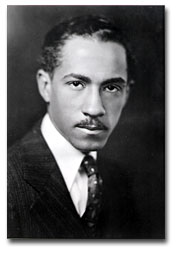
|
|
 |
||||||
|
|
|||||||
James Lesesne Wells was a leading graphic artist and art teacher, whose work reflected the vitality of the Harlem Renaissance.
He was born in Atlanta, Georgia on November 2, 1902. His father was a Baptist minister and his mother a teacher. At an early age, he moved to Florida with his family. His first experience as an artist was through his mother, who encouraged him to help out with art instruction in her kindergarten classes. At the age of thirteen, he won first prize in painting and a second prize in woodworking at the Florida State Fair.
Wells studied at Lincoln University in Pennsylvania for a year before transferring to Columbia University in New York, where he majored in art. His exposure to an exhibition of African sculpture at the Brooklyn Museum of Art was an inspiration to him. He was also greatly influenced by the woodcuts of Albrecht Durer and the German Expressionists — Ernst Kirchner, Karl Schmidt-Rottluff, Otto Muller, and Emile Nolde. Unlike most of his contemporaries, he saw prints as a major art form.
After graduation, Wells created block prints to illustrate articles and publications
such as Willis Richardson’s ![]() Plays
and Pageants of Negro Life. His work was included in an exhibition of
"International Modernists" in April 1929
at the New Art Circle Gallery owned by J.B. Neumann.
Plays
and Pageants of Negro Life. His work was included in an exhibition of
"International Modernists" in April 1929
at the New Art Circle Gallery owned by J.B. Neumann.
Later in 1929, he was invited to join the faculty at Howard University as a crafts teacher. He taught clay modeling, ceramics, sculpture, metal and blockprinting. It took him two years to convince the school that he and linoleum cutting belonged in the College of Fine Arts.
 In
1931, he won the Harmon Gold Medal
for his expressionistic painting Flight Into Egypt. Neumann continued
to exhibit Wells’s work along with those of the German expressionists and
American Arthur Dove. Art dealers Curt Valentin and Andrew Weyhe also showed
his work.
In
1931, he won the Harmon Gold Medal
for his expressionistic painting Flight Into Egypt. Neumann continued
to exhibit Wells’s work along with those of the German expressionists and
American Arthur Dove. Art dealers Curt Valentin and Andrew Weyhe also showed
his work.
During the Depression, Wells served as the director of a summer art workshop in an old Harlem nightclub. His assistants included such famous artists as Charles Alston, Jacob Lawrence, Palmer Hayden and Georgette Seabrooke.
The fine arts serigraph was developed during the Depression by the Works Project Administration to make art more accessible to the masses. Prints were also seen as a way of communicating African-American history and concerns. Therefore, between 1933-1934 Wells decided to devote himself almost exclusively to printmaking. He said:
"Becoming aware of the social and economic conditions of the time and the awakening of the 'New Negro,' I felt that the graphic arts would lend itself readily to the projection of ideas about these issues."
One of Wells’s strongest supporters was Alain Locke,
author of ![]() The
New Negro and
The
New Negro and ![]() Negro
Art: Past and Present. When Wells’s The Entry in Jerusalem
and The Ox-Cart were purchased by the Phillips Collection in Washington,
D.C., Locke wrote that "his inclusion in one of the most authoratively
chosen collections of modernist art in the country ranks Wells as an ultra-modernist
and a successful one."
Negro
Art: Past and Present. When Wells’s The Entry in Jerusalem
and The Ox-Cart were purchased by the Phillips Collection in Washington,
D.C., Locke wrote that "his inclusion in one of the most authoratively
chosen collections of modernist art in the country ranks Wells as an ultra-modernist
and a successful one."
Wells was an innovator in the field of printmaking. After World War II, he spent a sabbatical year working in Stanley Hayter’s Atelier 17, the most innovative center for etching and printmaking in the country. During the 1950s and 1960s, he continued to teach and won many art prizes.
Wells joined his brother-in-law, Eugene Davidson, president of the local NAACP chapter, in protesting segregation in lunch counters, stores, and the nearly all white police department and as a result, was often harassed. This persecution probably accounted for some of the religious themes in his work.
Painter Jacob Kainen wrote of him:
"Wells is more than an artist with a deep concern for his fellow man. He carries many of his themes a step further into an apocalyptic world, a world of revelation and shifting lights."
Wells retired from Howard University in 1968 but continued to paint and make prints into his eighties. Color linoleum prints became his specialty. In 1986, the Washington Project for the Arts assembled a major exhibition of his work, and in 1973, Fisk University mounted another one man show. His work Flight into Egypt was exhibited in 1990 in the Harmon’s "Against the Odds" exhibition and still looked as modern as it had when it was created.
Wells died on January 20, 1993 at the age of ninety. His legacy lives on in the works of his many students.
Art VF Art, American-DC Wells, James Lesesne, 1902-1993
![]() Bearden,
Romare and Harry Henderson. A History of African-American Art: From 1792
to the Present. New York: Pantheon Books, 1993.
Bearden,
Romare and Harry Henderson. A History of African-American Art: From 1792
to the Present. New York: Pantheon Books, 1993.
Photo Credit: James Lesesne Wells, ca. 1930s. Photographer unknown. Reproduced with permission, Photographs and Prints Division, Schomburg Center for Research in Black Culture, The New York Public Library. Astor, Lenox and Tilden Foundations.
biographies | harlem
renaissance books | links | timeline
black renaissance home | dclibrary.org
home
The Black Renaissance in Washington, D.C., 1920-1930s
http://www.dclibrary.org/blkren/
| last updated June 20, 2003